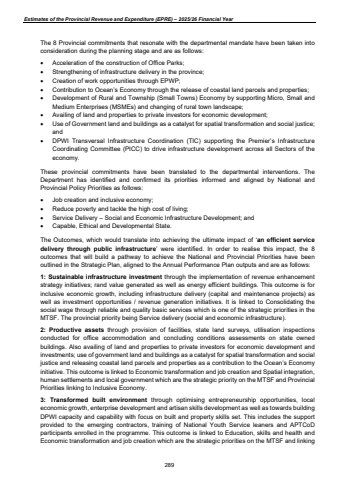Page 310 - Demo
P. 310
Estimates of the Provincial Revenue and Expenditure (EPRE) %u2013 2025/26 Financial YearThe 8 Provincial commitments that resonate with the departmental mandate have been taken into consideration during the planning stage and are as follows: %uf0b7 Acceleration of the construction of Office Parks; %uf0b7 Strengthening of infrastructure delivery in the province; %uf0b7 Creation of work opportunities through EPWP; %uf0b7 Contribution to Ocean%u2019s Economy through the release of coastal land parcels and properties; %uf0b7 Development of Rural and Township (Small Towns) Economy by supporting Micro, Small and Medium Enterprises (MSMEs) and changing of rural town landscape; %uf0b7 Availing of land and properties to private investors for economic development; %uf0b7 Use of Government land and buildings as a catalyst for spatial transformation and social justice; and %uf0b7 DPWI Transversal Infrastructure Coordination (TIC) supporting the Premier%u2019s Infrastructure Coordinating Committee (PICC) to drive infrastructure development across all Sectors of the economy. These provincial commitments have been translated to the departmental interventions. The Department has identified and confirmed its priorities informed and aligned by National and Provincial Policy Priorities as follows: %uf0b7 Job creation and inclusive economy; %uf0b7 Reduce poverty and tackle the high cost of living; %uf0b7 Service Delivery %u2013 Social and Economic Infrastructure Development; and %uf0b7 Capable, Ethical and Developmental State. The Outcomes, which would translate into achieving the ultimate impact of %u2018an efficient service delivery through public infrastructure%u2019 were identified. In order to realise this impact, the 8 outcomes that will build a pathway to achieve the National and Provincial Priorities have been outlined in the Strategic Plan, aligned to the Annual Performance Plan outputs and are as follows: 1: Sustainable infrastructure investment through the implementation of revenue enhancement strategy initiatives; rand value generated as well as energy efficient buildings. This outcome is for inclusive economic growth, including infrastructure delivery (capital and maintenance projects) as well as investment opportunities / revenue generation initiatives. It is linked to Consolidating the social wage through reliable and quality basic services which is one of the strategic priorities in the MTSF. The provincial priority being Service delivery (social and economic infrastructure). 2: Productive assets through provision of facilities, state land surveys, utilisation inspections conducted for office accommodation and concluding conditions assessments on state owned buildings. Also availing of land and properties to private investors for economic development and investments; use of government land and buildings as a catalyst for spatial transformation and social justice and releasing coastal land parcels and properties as a contribution to the Ocean%u2019s Economy initiative. This outcome is linked to Economic transformation and job creation and Spatial integration, human settlements and local government which are the strategic priority on the MTSF and Provincial Priorities linking to Inclusive Economy. 3: Transformed built environment through optimising entrepreneurship opportunities, local economic growth, enterprise development and artisan skills development as well as towards building DPWI capacity and capability with focus on built and property skills set. This includes the support provided to the emerging contractors, training of National Youth Service leaners and APTCoD participants enrolled in the programme. This outcome is linked to Education, skills and health and Economic transformation and job creation which are the strategic priorities on the MTSF and linking 289


